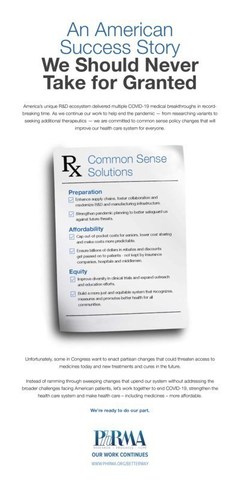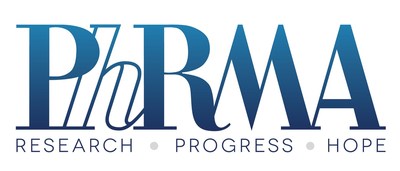|
13.04.2021 23:48:00
|
PhRMA's Three-part Approach to Build a Better Health Care System
WASHINGTON, April 13, 2021 /PRNewswire/ -- On April 3, more than four million Americans received a COVID-19 vaccine — the largest single-day vaccination event in human history. For innovators across the pharmaceutical industry, these moments make the years — sometimes decades — of painstaking trial and error worth it.

I'm incredibly proud of our industry's role in combating this pandemic. At the same time, our battle against COVID-19 has driven home an important reality: We need to build a better health care system that ensures scientific advances are accessible and affordable to everyone who needs them.
To that end, today we are releasing a series of policies we believe will help our country reach that goal. Our plan is based on three key pillars: ending the pandemic and building a more resilient system, making medicines more affordable and building a more just, equitable health care system.
Ending the Pandemic and Building a More Resilient System
America's unique research and development ecosystem allowed our industry to develop COVID-19 vaccines and treatments at unprecedented speed. We need to preserve that ecosystem while enhancing our ability to quickly respond to future public health disasters.
That starts with collaboration among biopharmaceutical companies, government agencies and others in the public and private sector, which has been critical in our nation's COVID-19 response. Future policy should avoid measures that would impede this collaboration, such as the erosion of intellectual property protections and reduced incentives for research and development.
A policy framework guided by innovation and collaboration will allow our industry to expand R&D and manufacturing infrastructure as well as build more diverse, reliable supply chains. And we are calling on our elected leaders to tackle a growing public health threat we know exists and before it's too late: the spread of antibiotic-resistant superbugs. Last summer, our companies stepped up with a major commitment to help develop new antibiotics, and it's time policymakers stepped up too.
While the development of new vaccines and treatments occurred in record time, the pandemic has highlighted weaknesses in our health care infrastructure, gaps that led to delays in testing, bottlenecks in the distribution of vaccines and other challenges. We are proposing a number of policies that will help address these weaknesses and ensure our health care system is more resilient in the face of future public health emergencies.
Making Medicines More Affordable
While biopharmaceutical companies make and set initial prices for medicines, middlemen, insurers, hospitals and others affect the prices that patients ultimately pay. In 2018, nearly half of the money spent on brand medicines went to someone other than the research companies that discover and manufacture medicines, like pharmacy benefit managers, insurers, hospitals and others in the biopharmaceutical supply chain. Meanwhile, a greater share of the cost of medicine has shifted onto patients. The system is working for everyone except patients, and we are ready to do our part to fix it.
Across the board, private insurance should work more like insurance is supposed to: spreading costs broadly and providing affordable coverage when people are sick. For example, insurers should cover more medicines from day one for patients with chronic illnesses who are often penalized by high costs.
Insurers should also pass on more savings to patients. When insurers don't pay full price, patients shouldn't either.
Additionally, insurance companies pocket rebates, while at the same time using tools like copay accumulator programs to punish patients who rely on copay assistance to help cover their out-of-pocket expenses. We need to prohibit insurance practices like this that are designed to trap patients in costly deductibles.
Changes to Medicare Part D, the Medicare prescription drug benefit program — such as capping annual out-of-pocket payments for prescription medicines, lowering cost sharing and making those costs more predictable — could dramatically reduce out-of-pocket costs for seniors. And for the Medicare Part B program, which covers some of the most innovative medicines and more vulnerable patients, we support finding ways to reduce costs. That is why we are proposing a market-based adjustment that would allow the program to receive more of the benefits of the lower prices negotiated in the commercial market. This would help save seniors hundreds – if not thousands – of dollars a year, while protecting access to their medicines.
Building a More Just, Equitable Health Care System
COVID-19 has disproportionately affected communities of color. People of color were less likely to have quality health care when the pandemic hit, and were much more likely to work and live in conditions that made social distancing nearly impossible. The impact has been tragic — and largely preventable.
That's why, moving forward, we're making diversity, equity and inclusion part of our mission. And we are already making progress. Today, voluntary principles adopted by our industry to encourage greater clinical trial diversity will go into effect. The principles will help ensure future clinical trials better reflect the intended treatment population.
We're also supporting the collection of more robust data that will allow us to more quickly identify and address health disparities. Persistent disparities limit any gains we make in overall health and drive higher costs throughout the system. These steps are the beginning, not the end, of our equity efforts. We'll continue to explore structural changes in health care that would create more incentives for equitable access and outcomes.
In many respects, the idea of returning to a pre-pandemic life is exhilarating. As we continue our efforts to bring the pandemic to an end, we should not miss the opportunity to learn from it and use those lessons to build a stronger, more resilient, affordable and equitable health care system. To learn more about our plan to build that better health care system for all Americans, visit here.
This post originally appeared on PhRMA's Catalyst blog.
CONTACT: Brian Newell, newsroom@phrma.org, 202-835-3460

![]() View original content to download multimedia:http://www.prnewswire.com/news-releases/phrmas-three-part-approach-to-build-a-better-health-care-system-301268237.html
View original content to download multimedia:http://www.prnewswire.com/news-releases/phrmas-three-part-approach-to-build-a-better-health-care-system-301268237.html
SOURCE Pharmaceutical Research and Manufacturers of America (PhRMA)
 Der finanzen.at Ratgeber für Aktien!
Der finanzen.at Ratgeber für Aktien!
Wenn Sie mehr über das Thema Aktien erfahren wollen, finden Sie in unserem Ratgeber viele interessante Artikel dazu!
Jetzt informieren!